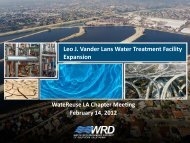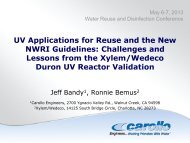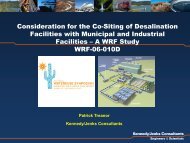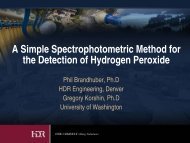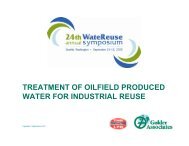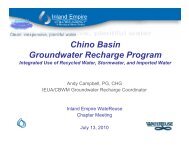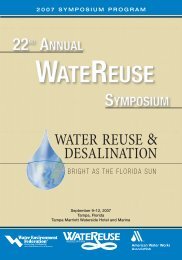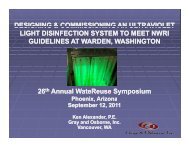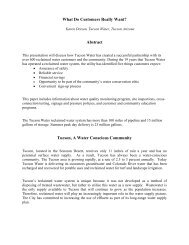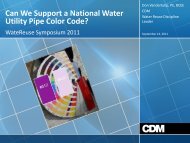Desalination Plant Intakes - WateReuse Association
Desalination Plant Intakes - WateReuse Association
Desalination Plant Intakes - WateReuse Association
Create successful ePaper yourself
Turn your PDF publications into a flip-book with our unique Google optimized e-Paper software.
WATEREUSE ASSOCIATIONDESALINATION COMMITTEE<strong>Desalination</strong> <strong>Plant</strong> <strong>Intakes</strong> –Impingement and Entrainment Impacts and SolutionsWhite PaperINTRODUCTIONSeawater intakes are an integral part of every seawater desalination plant. The purpose of thiswhite paper is to provide an overview of potential impingement and entrainment (I&E) impactsassociated with the operation of open ocean intakes for seawater desalination plants and todiscuss alternative solutions for efficient and cost effective I&E reduction. For information onalternative intakes for seawater desalination plants, refer to the <strong>WateReuse</strong> <strong>Association</strong>’s whitepaper titled “Overview of <strong>Desalination</strong> <strong>Plant</strong> Intake Alternatives.”WHAT IS IMPINGEMENT AND ENTRAINMENT?As with any other natural surface water source currently used for fresh water supply around theglobe, seawater contains aquatic organisms (algae, plankton, fish, bacteria, etc.). Impingementoccurs when organisms sufficiently large to avoid going through the screens are trapped againstthem by the force of the flowing source water – i.e., algae, plankton and bacteria are not exposedto impingement. On the other hand entrainment occurs when marine organisms enter thedesalination plant intake, are drawn into the intake system, and pass through to the treatmentfacilities.Impingement typically involves adult aquatic organisms (fish, crabs, etc.) that are large enoughto actually be retained by the intake screens, while entrainment mainly affects aquatic speciessmall enough to pass through the particular size and shape of intake screen mesh. Impingementand entrainment of aquatic organisms are not unique to open intakes of seawater desalinationplants only. Conventional open freshwater intakes from surface water sources (i.e., rivers, lakes,estuaries) may also cause measurable impingement and entrainment.A third term, “entrapment,” is then used when describing impacts associated with offshore intakestructures connected to an on-shore intake screen and pump station via long conveyance pipelineor tunnel. Organisms that enter the offshore intake and cannot swim back out of it are oftenreferred to as entrapped 1 . Such marine organisms could either be impinged on the intake screensor entrained if they pass through the screens and enter the downstream facilities of thedesalination plant.1 http://www.waterlink-international.com/download/whitepaper_uploadfile_21.pdfSeawater <strong>Desalination</strong> <strong>Plant</strong> <strong>Intakes</strong> – Impingement and Entrainment Page 1
Source: Water Globe ConsultingFigure 2 – Fine Intake ScreenBy comparison, intake wells and infiltration galleries pre-filter aquatic life through the oceanbottom sediments. In this case, the ocean bottom provides a natural separation barrier for adultand juvenile marine organisms. Since subsurface intakes collect source seawater through theocean bottom and coastal aquifer sediments (see Figure 3), they are not expected to exert animpingement type of impact on the marine species contained in the source seawater. However,the magnitude of potential entrainment of marine species into the bottom sediments caused bycontinuous subsurface intake operations is not well known and has not been systematically andscientifically studied to date. An ongoing side-by-side study of the I&E effects of a subsurfaceintake and an open ocean intake equipped with a passive wedgewire screen at the West BasinMunicipal Water District’s desalination demonstration plant is expected to provide more detailedinformation on this topic 2 .2 http://www.watereuse.org/node/978Seawater <strong>Desalination</strong> <strong>Plant</strong> <strong>Intakes</strong> – Impingement and Entrainment Page 3
Source: Kennedy/Jenks ConsultantsFigure 3 – Subsurface Intake SchematicA comprehensive multi-year impingement and entrainment assessment study of the open oceanintakes of 19 power generation plants using seawater for once-through cooling completed by theCalifornia State Water Resources Control Board in 2010 provides important insight into themagnitude of these intake-related environmental impacts 3 . Based on this study, the estimatedtotal average annual impingement of fish caused by the seawater intakes varied between 0.31pounds (lbs.) per million gallons a day (MGD) of collected seawater (Diablo Canyon Power<strong>Plant</strong>) and 52.29 lbs./MGD (Harbor Generating Station); and for all 19 plants it averaged 6.63lbs./MGD. Taking into consideration that this amount is the total annual impact, the averagedaily impingement rate is estimated to be 0.018 lbs./MGD of intake flow (6.63 lbs./365 days =0.018 lbs./MGD).Using the California State Water Resources Control Board impingement and entrainment studyresults as a baseline, for a large desalination plant of 50 MGD production capacity collecting 110MGD of intake flow, the daily impingement impact is projected to be 2 lbs. per day (0.018lbs./MGD x 110 MGD = 2 lbs./day). This impingement impact is less than the daily food intakeof one pelican – up to 4.0 lbs./day 4 . The comparison illustrates the fact that the impingementimpact of seawater desalination plants with open ocean intakes is not significant and would nothave measurable impact on natural aquatic resources (Figure 4).3 http://www.watereuse.org/sites/default/files/u8/Quote 3.pdf4http://www.sandiegozoo.org/animalbytes/t-pelican.htmlSeawater <strong>Desalination</strong> <strong>Plant</strong> <strong>Intakes</strong> – Impingement and Entrainment Page 4
Source: US Fish and Wildlife ServiceFigure 4 – Average Daily <strong>Desalination</strong> Intake Impingement Impact Is Less than the DailyFish Intake of One PelicanThe California State Water Resources Control Board report mentioned earlier also gives abaseline for assessment of the entrainment impact of seawater intakes. The study indicates thatthe magnitude of such annual impact on larval fish can vary in a wide range – from 0.08 million(MM)/MGD (Contra Costa Power <strong>Plant</strong>) to 5.8 MM/MGD (Encina Power <strong>Plant</strong>) and illustratesthe fact that the entrainment impact is very site-specific.As per the same report, the average annual entrainment is estimated at 2.14 million of fish larvaeper MGD of intake flow. Prorated for a 110 MGD intake of a 50 MGD seawater desalinationplant, this annual entrainment impact is 235.4 MM of larval fish/yr. While this number seemslarge, based on expert evaluation and research, large entrainment numbers do not necessarilyequate to a measurable impact to adult fish populations because of the enormous amount of eggs,fish larvae and other zooplankton in seawater 5 . Due to the large natural attrition of larval fish,very few larval fish actually develop to juvenile and adult stages in the natural environment (seeFigure 5) 6 . The majority of larvae are lost to predation, exposure to destructive forces of naturesuch as wind and wave action, and the inability to find appropriately-sized pray during the5 http://www.swrcb.ca.gov/water_issues/programs/ocean/cwa316/docs/workshop_oakland2005/pres_tenera.pdf6 http://www.scwd2desal.org/documents/Presentations/Nov_10_2010/02_Tenera_nov10_web.pdfSeawater <strong>Desalination</strong> <strong>Plant</strong> <strong>Intakes</strong> – Impingement and Entrainment Page 5
critical period of their development (i.e., after their yolk sack is empty). All of these forces haveseveral orders of magnitude higher impact on fish populations than seawater intakes.Source: Tenera EnvironmentalFigure 5 – Typical Reproduction and Survival of Larval Producing OrganismsFor example, a single female halibut produces as many as 50 million eggs per year for as long as20 years, or one billion eggs over a lifetime 7 . In simple terms, the annual entrainment impact ofone 50 MGD desalination plant would be comparable to the annual bio-productivity of fiveadult female halibut fish (i.e., the “environmental impact” which five fishermen can cause withtheir daily halibut catch quota of one fish each).The environmental impact of desalination plant operations should be assessed in the context ofthe environmental impacts of water supply alternatives that may be used instead of desalination.<strong>Desalination</strong> projects are typically driven by the limited availability of alternative lower-costwater supply resources such as groundwater or fresh surface water (rivers, lakes, etc.). However,damaging long-term environmental impacts may also result from continued over-depletion ofthose conventional water supplies, including inter-basin water transfers. For example, overpumpingof fresh water aquifers over the years in a number of areas worldwide (i.e., the SanFrancisco Bay Delta in Northern California; wetlands in the Tampa Bay region of Florida; andfresh water aquifers, and rivers and lakes in northern Israel and Spain, which supply water tosustain agricultural and urban centers in the southern regions of these countries), has resulted insubstantial environmental impacts to the traditional fresh water resources in these regions. One7 http://www.watereuse.org/sites/default/files/u8/Quote%207%20-%20Presentation.pdfSeawater <strong>Desalination</strong> <strong>Plant</strong> <strong>Intakes</strong> – Impingement and Entrainment Page 6
such specific example of dramatic environmental impact is the reduction of the habitat of deltasmelt as a result of over-pumping caused by California State Water Project’s intake facilities. 8Such long-term fresh water transfers have affected the ecological stability in the fresh waterhabitats to the extent that the long-term continuation of current water supply practices may resultin significant and irreversible damage of the ecosystems of traditional fresh water supply sourcesand even the intrusion of saline water into the freshwater aquifers, such as the case in SalinasValley, Monterey County, California. In such instances, the environmental impacts ofconstruction and operation of new seawater desalination projects should be weighed against theenvironmentally damaging consequences from the continued expansion of the existing freshwatersupply practices.A responsible approach to water supply management must ensure that sustainable and droughtprooflocal supplies are available, and long-term reliance on conventional water supply sources(i.e., surface water, groundwater) is reconsidered in favor of a well-balanced and diversifiedwater supply portfolio which combines surface water, groundwater, recycled water, waterconservation, and desalination. For example, this type of reliability-driven, balanced watersupply program is currently implemented by West Basin Municipal Water District(www.westbasin.org), the Texas Water Development Board, Tampa Bay Water, and otheragencies in the United States.IMPINGEMENT AND ENTRAINMENT SOLUTIONSWhile impingement and entrainment associated with seawater intake operations are not expectedto create biologically significant impacts under most circumstances, best available site, design,technology, and when needed, mitigation measures, are prudent for minimizing loss of marinelife and maintaining the productivity and vitality of the aquatic environment in the vicinity of theintake.Prudent Open Intake DesignInstallation of Intake Inlet Structure Outside of the Littoral Zone<strong>Intakes</strong> in the littoral zone (i.e., the near-shore zone encompassed by low and high tide levels)have the greatest potential to cause elevated impingement and entrainment impacts. The US EPAconsiders extending intakes 125 meters (410 feet) outside of the littoral zone a good engineeringpractice aimed at reduced impingement and entrainment 9 . According to the Office of NavalResearch, the littoral zone extends 600 feet from the shore 10 . Thus, intakes with an inlet structurelocated at least 1100 feet from the shore could result in reduced environmental impacts. Inaddition, installing the intake to depths where there is a lower concentration of living organisms8 http://www.science.calwater.ca.gov/pdf/eco_restor_delta_smelt.pdf9 http://water.epa.gov/lawsregs/lawsguidance/cwa/316b/phase1/upload/2009_04_02_316b_phase1_support_contents.pdf10 http://www.onr.navy.mil/focus/ocean/regions/littoralzone1.htmSeawater <strong>Desalination</strong> <strong>Plant</strong> <strong>Intakes</strong> – Impingement and Entrainment Page 7
energy consumption is achieved at a membrane flux of 9.0 gallons per square feet per day (gfd)and RO system recovery of 48% 13 .Most desalination plants collect 4 to 10% of additional water to wash their pretreatment filtrationsystems and discharge the spent filter backwash water back to the ocean. A design approachwhich may allow reducing this water use significantly is treatment and reuse of the backwashwater. Such a backwash treatment and reuse approach has cost implications but is a prudentdesign practice aimed at reducing overall plant seawater intake flow and associated impingementand entrainment.Collecting additional seawater for concentrate pre-dilution may be needed when existingwastewater intake or power plant outfalls are used for concentrate discharge and the existingoutfall volume is not sufficient to produce adequate dilution of the saline discharge. Thisadditional flow intake could be eliminated by designing facilities for storing concentrate duringperiods of low outfall flows when adequate dilution is not available, or by installing a dischargediffuser system which allows enhancing concentrate dissipation into the ambient marineenvironment without additional dilution.If the desalination plant production capacity has to vary diurnally, the design and installation ofvariable frequency drives on the intake pumps could also allow decreasing impingement andentrainment of the plant intake by closely matching collected source seawater volume to theplant production needs.Use of Low-Impact Intake TechnologiesImpingement and entrainment of marine organisms could be minimized by using varioussubsurface and open intake technologies. Currently, there are no federal and state regulationswhich specifically define requirements for reduction of impingement and entrainment caused bydesalination plant intakes. However, the US EPA Section 316(b) of the Clean Water Act federalregulations have stipulated national performance standards for intake impacts from powergeneration plants which require 80 to 95% reduction of impingement and 60 to 90% reduction ofentrainment as compared to those caused by uncontrolled intake conditions 14 . Technologies thatcan meet these impingement and entrainment performance standards are defined by US EPA asBest Technology Available (BTA).Subsurface <strong>Intakes</strong>Subsurface intakes (vertical and horizontal directionally drilled wells, slant wells and infiltrationgalleries) are considered a low-impact technology in terms of impingement and entrainment.However, to date there are no studies that document the actual level of entrainment reduction that13 http://www.affordabledesal.com/home/news/ADC%20Completes%20Profile%20of%20SWRO%203-28-08.pdf14 http://edocket.access.gpo.gov/cfr_2008/julqtr/pdf/40cfr125.94.pdfSeawater <strong>Desalination</strong> <strong>Plant</strong> <strong>Intakes</strong> – Impingement and Entrainment Page 9
can be achieved by these types of intakes. In addition, the potential application of a subsurfaceintake is very site specific and highly dependent on the project size; the coastal aquifer geology(aquifer soils, depth, transmissivity, water quality, capacity, etc.); the intensity of the naturalbeach erosion in the vicinity of the intake site; and on many other environmental and socioeconomicfactors.Because optimal conditions for subsurface intakes are often impossible to find in the vicinity ofthe desalination plant site, the application of this type of intake technology to date worldwide hasbeen limited to plants of relatively small capacity. As indicated in <strong>WateReuse</strong> <strong>Association</strong>’sWhite Paper titled “Overview of <strong>Desalination</strong> <strong>Plant</strong> Intake Alternatives,” 15 the largest seawaterdesalination facility with a subsurface intake in operation at present is the first 17 MGD phase ofthe 34 MGD San Pedro Del Pinatar (Cartagena) desalination plant in Spain. For this project, sitespecifichydrogeological constraints made it impossible to use intake wells for plant expansion,and the second 17 MGD phase of this project was constructed with an open intake.Ongoing long-term studies of innovative subsurface intakes in Long Beach and Dana Point,California are expected to provide comprehensive data that would allow completing ascientifically-based analysis of the viability and performance benefits of subsurface intakes forlarger-size applications. The tested subsurface intake technologies are currently under evaluationand do not yet have established performance, reliability, and environmental track records.Wedgewire Screen <strong>Intakes</strong>Wedgewire screens are cylindrical metal screens with trapezoidal-shaped “wedgewire” slots withopenings of 0.5 to 10 mm. They combine very low flow-through velocities, small slot size, andnaturally occurring high screen surface sweeping velocities to minimize impingement andentrainment. This is the only open intake technology approved by US EPA as Best TechnologyAvailable. Such approval, however, is granted provided that sufficient ambient conditions existto promote cleaning of the screen face; the through screen design intake velocity is 0.5 feet/secor less; and the slot size is appropriate for the size of eggs, larvae, and juveniles of any fish andshellfish to be protected at the plant intake site 16 .Wedgewire screens are designed to be placed in a water body where significant prevailingambient cross flow current velocities (≥ 1 fps) exist. This high cross-flow velocity allowsorganisms that would otherwise be impinged on the wedgewire screen intake to be carried awaywith the flow.15 http://www.watereuse.org/node/134016 http://edocket.access.gpo.gov/cfr_2006/julqtr/pdf/40cfr125.99.pdfSeawater <strong>Desalination</strong> <strong>Plant</strong> <strong>Intakes</strong> – Impingement and Entrainment Page 10
An integral part of a typical wedgewire screen system is an air burst back-flush system, whichdirects a charge of compressed air to each screen unit to blow-off debris back into the waterbody, where they are carried away from the screen unit by the ambient cross-flow currents.Figure 6 presents a schematic of the wedgewire screen intake used at the 40 MGD Becktondesalination plant in London, England. The Beckton desalination plant is equipped with seven(7) 3-mm wedgewire screens installed on the suction pipe of each of the plant intake pumps.Total screen length is 11.55 ft. (3500 mm) and the screen diameter is 3.6 ft. (1100 mm). Theplant intake is under significant influence of tidal exchange of river water and seawater. Tocapture the ebb tide and minimize entrainment, the intake adjusts as it also targets lower salinitywaters.Source: Acciona AguaFigure 6 – Wedgewire Screen Intake of Beckton <strong>Desalination</strong> <strong>Plant</strong>An I&E study of a cylindrical wedgewire screen (Figure 7) was conducted over a 13-monthperiod from April 2009 through May 2010 by Tenera Environmental for a seawater desalinationproject currently under development by the City of Santa Cruz Water Department and SoquelCreek Water District in California 17 . The intake for the full-scale desalination project would bedesigned to collect of up to 7.0 MGD of source seawater in order to produce an average of 2.5MGD of fresh drinking water.17 http://www.scwd2desal.org/documents/Reports/Open_Ocean_Intake_Effects/Open%20Ocean%20Intake%20Effects%20Study%20Final%20Dec%202010.pdfSeawater <strong>Desalination</strong> <strong>Plant</strong> <strong>Intakes</strong> – Impingement and Entrainment Page 11
The tested wedgewire screen had 2.0 mm of slot openings and was constructed of copper-nickelalloy. The diameter of the screen was 8-5/8 inches; the overall screen length was 35 inches; andthe outer flange was 6-5/8 inches. Seawater was pumped from a depth of 15 to 20 feet beneaththe sea surface.Source: Tenera EnvironmentalFigure 7 – Wedgewire Screen Used in Santa Cruz I&E StudyThe results of this comprehensive I&E study indicate that:• No endangered, threatened, or listed species were entrained.• At an average intake velocity of 0.33 fps, the screen was successful in completelyeliminating impingement.• The wedgewire prevented entrainment of adult and juvenile fish species.• The greatest projected proportional mortality that could be attributed to the screenoperation for the top 80% of the fish larvae in the source water area at 7.0 MGD intakeflow was 0.06%.• The greatest projected proportional mortality for the caridean shrimp and cancrid crablarvae in the source water area for 7.0 MGD intake flow was 0.02%.• The extremely low proportional losses of fish, shrimp and crab populations indicate thatthe full-scale wedgewire intake screen operation at 7.0 MGD will not cause significantSeawater <strong>Desalination</strong> <strong>Plant</strong> <strong>Intakes</strong> – Impingement and Entrainment Page 12
environmental impact considering that the natural mortality rates of these species are over99.9%.• The absolute numbers of larvae projected to be entrained annually due to the collection of7.0 MGD of source seawater for desalination plant operation are a very small fraction ofthe reproductive output of the source populations of marine organisms inhabiting theintake area. For example, for the white croaker – a fish frequently encountered in theintake area – the potential larval losses (fecundity losses) are 3.6 million larvae, whichare comparable to the total lifetime fecundity (reproductive yield) of a single female fish.To study the behavioral responses of different species swimming near or contacting thewedgewire screens, two underwater video cameras were installed to view the surface of thescreens during operation. One camera was oriented to provide a lengthwise view of the screen’ssurface while a second camera videotaped a top view of the screen’s surface. Videos weredisplayed and recorded to a digital video recorder (DVR) when the intake pump was operated.Figures 8, 9 and 10 present still photographs from the impingement video. The video footageshows that all fish, amphipods, and shrimps that encountered the screen were able to freethemselves after contacting the screen. The video observations allow the conclusion thatoperating the wedgewire screen intake at a through-screen velocity of 0.33 fps eliminatesimpingement.Source: Tenera EnvironmentalFigure 8 – Rockfish Sitting on ScreenSeawater <strong>Desalination</strong> <strong>Plant</strong> <strong>Intakes</strong> – Impingement and Entrainment Page 13
Source: Tenera EnvironmentalFigure 9 – Shrimps Swimming Near ScreenSource: Tenera EnvironmentalFigure 10 – School of Juvenile Rockfish Swimming Near ScreenSeawater <strong>Desalination</strong> <strong>Plant</strong> <strong>Intakes</strong> – Impingement and Entrainment Page 14
A wedgewire screen intake I&E study has also been completed at the Marin Municipal WaterDistrict SWRO pilot plant near San Francisco, CA 18 . The results of this study indicated that noimpingement was observed and the larval entrainment losses were found to be less than 0.2% ofthe total larval population in the intake area of the desalination plant. The use of cylindricalwedgewire screens is also currently being tested at the West Basin Municipal Water Districtseawater desalination demonstration plant in California.Offshore Intake Velocity CapA velocity cap is a configuration of the open intake structure that is designed to change the maindirection of water withdrawal from vertical to horizontal (see Figure 11). This configuration isbeneficial for two main reasons: (1) it eliminates vertical vortices and avoids withdrawal fromthe more productive aquatic habitat which usually is located closer to the surface of the waterbody; and (2) it creates a horizontal velocity pattern which gives juvenile and adult fish anindication for danger – most fish have receptors along the length of their bodies that sensehorizontal movement because in nature such movement is associated with unusual conditions.This natural indication combined with maintaining low through-screen velocity (0.5 fps or less)provides fish in the area of the intake ample warning and opportunity to swim away from theintake.The velocity cap intake configuration has a long track record and is widely used worldwide. Thisis the original configuration of many power plant intakes in Southern California and of all newlarge seawater desalination plants in Australia, Spain, and Israel constructed over the last fiveyears. Based on a US EPA technology efficacy assessment, velocity caps could provide over50% impingement reduction and can minimize entrainment and entrapment of marine speciesbetween the inlet structure and the fine plant screens 19 .18 http://www.marinwater.org/controller?action=menuclick&id=44619 http://www.epa.gov/waterscience/316b/phase1/technical/ch5.pdfSeawater <strong>Desalination</strong> <strong>Plant</strong> <strong>Intakes</strong> – Impingement and Entrainment Page 15
Source: US EPAFigure 11 – Velocity Cap for Entrainment ReductionAs indicated previously, open intakes may also exhibit an entrapment effect – fish and othermarine organisms that are drawn into the offshore conduit cannot return back to the open oceanbecause they are stranded between the intake inlet structure and the downstream fine screens.The use of velocity caps and low velocity through both the coarse screen of the intake structureand the downstream fine screens could reduce this entrapment effect.Other Impingement and Entrainment Reduction TechnologiesIn addition to the intake technologies described above, there are a number of other technologieswhich have been demonstrated to reduce the impingement and entrainment of open intakeoperations, mainly based on testing at existing power plant intakes. Table 1 below provides asummary of such technologies. Not all of the technologies listed in the table can meet the USEPA performance targets under all conditions and circumstances or deliver both impingementand entrainment benefits. However, if needed, these technologies could be used in synergisticcombination to achieve project-specific environmental impact reduction targets. Some of thetechnologies listed in Table 1 (such as velocity caps, acoustic barriers, wedgewire screens andfine mesh travelling screens) have found full-scale applications for recently implementedseawater desalination projects. In mid-2011, the <strong>WateReuse</strong> Research Foundation initiated aresearch study to document and evaluate the impingement and entrainment reduction efficiencyof these and other technologies (<strong>WateReuse</strong>-10-04).Seawater <strong>Desalination</strong> <strong>Plant</strong> <strong>Intakes</strong> – Impingement and Entrainment Page 16
Table 1 – Potential Open Intake Impingement and Entrainment Reduction TechnologiesImpact Reduction PotentialType ofHow Do They Work?TechnologiesI&EReductionImpingement EntrainmentMeasuresPhysicalBarriersCollection&ReturnSystemsDiversionSystemsBehavioralDeterrentDevicesBy Blocking Fish Passageand Reducing IntakeVelocityEquipment is Installed onFine Screens for FishCollection and Return tothe OceanDevices Which Divert Fishfrom the Screens and DirectBack to the OceanRepulsing Organisms fromthe Intake by IntroducingChanges that Alert Them• Wedgewire Screens• Fine Mesh Screens• Microscreening Systems• Barrier Nets• Aquatic Filter Barriers• Ristroph TravellingScreens• Fine Mesh TravellingScreens• Angled Screens withLouvers• Inclined Screens• Velocity Caps• Acoustic Barriers• Strobe Lights• Air Bubble CurtainsYesYesYesYesYesNoYesNoAn example of the synergistic use of I&E reduction technologies is the previously referenced 40MGD Beckton desalination plant in London. Besides wedgewire screens, the intake structure ofthis plant is equipped with an acoustic fish deflection system. This system includes eight lowfrequency sound generation units that deflect fish movement away from the wedgewire intakestructure (Figure 12). The scale at the bottom of this figure indicates the sound level of theacoustic fish deflection system in decibels (dB). The low frequency (25 – 400 Hz) sound level ismaintained at a level of 150 dB or more, which gives a clear cue for danger to fish entering thearea of the intake. This acoustic system is only operated for short periods, twice daily, duringpump startup. At this time, no published data are available regarding the I&E reductionefficiency of this technology.Seawater <strong>Desalination</strong> <strong>Plant</strong> <strong>Intakes</strong> – Impingement and Entrainment Page 17
Source: Acciona AguaFigure 12 – Beckton <strong>Desalination</strong> <strong>Plant</strong> Intake Acoustic Fish Deflection SystemFine mesh screens are one of the technologies equally popular for both seawater desalination andpower plant intakes. One type of fine mesh screen associated with the operations of the 25 MGDTampa Bay seawater desalination plant is shown on Figure 13. This desalination plant iscollocated with the 1200 MW Big Bend Power <strong>Plant</strong> and uses cooling water from this plant assource seawater for desalination. The Tampa Bay desalination plant does not have a separateseawater intake. However, the intake of the power plant is equipped with 0.5-mm Ristroph finemeshscreens, which have been proven to reduce impingement and entrainment of fish eggs andlarvae through the downstream conventional bar and fine screens of the power plant intake byover 80% 20 .Unfortunately for the desalination plant, these screens are periodically bypassed (as allowed bypermit) and/or screenings are conveyed to the power plant discharge outfall from where thedesalination plant collects source seawater. As a result, the screenings can find their way to thedesalination plant intake and impact desalination plant pretreatment system performance. Thischallenge necessitated the need for the remediated desalination plant to be equipped in 2005 withanother set of fine screens located just upstream of the pretreatment facilities.20 http://www.epa.gov/waterscience/316b/phase1/technical/ch5.pdfSeawater <strong>Desalination</strong> <strong>Plant</strong> <strong>Intakes</strong> – Impingement and Entrainment Page 18
Source: Water Globe ConsultingFigure 13 – 0.5 mm Fine Mesh Screens of the Tampa Bay Power <strong>Plant</strong> IntakeAnother example of a full-scale implementation of an intake with advanced impingement andentrainment reduction features is the Filtrex Filter Intake System of the 10 MGD Taunton River<strong>Desalination</strong> <strong>Plant</strong> in Dighton, Massachusetts (Figure 14). This plant is planned to be constructedin two 5 MGD phases. The 30 MGD intake system for this plant is comprised of 30 racks with96, 4.6-inch long individual plastic filtration modules (candles) per rack, through which salinewater is withdrawn.The candles have a pore size of 0.04 mm (40 microns) and very low (0.2 feet/sec) through-porevelocity. These intake features allow complete avoidance of the impingement of adult fish; areduction of impingement of fish eggs down to less than 15%; and a minimization of entrainmentof larval organisms and fish eggs to less than 3% of the species in the intake area 21 . It should bepointed out that this type of screen has a limited track record because the plant began operationin November 2008 and has not been operating at its full 5 MGD production capacity as of yet.21 http://www.watereuse.org/sites/default/files/u8/Quote%2021.pdfSeawater <strong>Desalination</strong> <strong>Plant</strong> <strong>Intakes</strong> – Impingement and Entrainment Page 19
Source: TRI-MONT Engineering CompanyFigure 14 – Taunton River <strong>Desalination</strong> <strong>Plant</strong> IntakeEnvironmental Impact Mitigation MeasuresEnvironmental impact mitigation is typically applied if the site, design, and technology measuresdescribed above do not provide adequate impingement and entrainment reduction to sustain thebiological balance of the marine habitat in the area of the intake. Examples of types of activitiesthat may be implemented by desalination facilities to provide environmental impact mitigationinclude:• Wetland Restoration;• Coastal Lagoon Restoration;• Restoration of Historic Sediment Elevations to Promote Reestablishment of Eelgrass Beds;• Marine Fish Hatchery Enhancement;• Contribution to a Marine Fish Hatchery Stocking Program;• Artificial Reef Development; and• Kelp Bed Enhancement.The type and size of the mitigation alternative or combination of alternatives most suitable for agiven project are typically selected to create a new habitat capable of sustaining types of speciesSeawater <strong>Desalination</strong> <strong>Plant</strong> <strong>Intakes</strong> – Impingement and Entrainment Page 20
and levels of biological productivity comparable to those lost as a result of the intake operations.Coastal wetlands are the nursery areas for many of the species impacted by desalination intakes.Wetland restoration is, therefore, a common mitigation measure for large seawater intakesystems. For example, development of new coastal wetlands is the preferred impingement andentrainment mitigation alternative for the 50 MGD Carlsbad seawater desalination project inCalifornia.The time and cost expenditures involved in the permitting, implementation, maintenance, andmonitoring of such mitigation measures are significant, and such habitat restorative measures aretypically used when the impingement and entrainment reduction measures described in theprevious sections are not readily available or viable for a given project.Some environmental groups do not consider mitigation as an acceptable I&E managementalternative and have challenged the legality of the use of I&E mitigation measures for bothpower plant and desalination plant intakes. Court resolutions to recent legal challengesassociated with the permitting of the 50 MGD Carlsbad and Huntington Beach SWRO projects,however, indicate that mitigation by environmental restoration is a viable method forsupplementing the use of best technologies available and operational measures to address thepotential environmental impacts associated with collecting seawater for desalination.CONCLUDING REMARKSIn summary, appropriately sited, designed, and operated seawater desalination plant intakes canhave minimal environmental impacts on the marine environment and resources. In fact, based onrecent studies, impingement and entrainment resulting from well-planned and designed openocean intakes would be minor: the equivalent of the daily food intake of one pelican and the lossof the annual bio-productivity of five adult female halibut, respectively. Ongoing developmentsin impingement and entrainment reduction technology, combined with the existing wealth ofknowledge and experience in this field, both domestically and internationally, pave the way formaintaining sustainable and environmentally safe production of fresh water from the ocean. Withover 20 years of successful operational experience at more than 8000 desalination plantsworldwide, seawater desalination is currently a well-established drinking water productiontechnology of proven performance which will play an increasingly prominent role in wellbalanced and sustainable water supply portfolios of coastal communities in the US and abroad.Seawater <strong>Desalination</strong> <strong>Plant</strong> <strong>Intakes</strong> – Impingement and Entrainment Page 21



